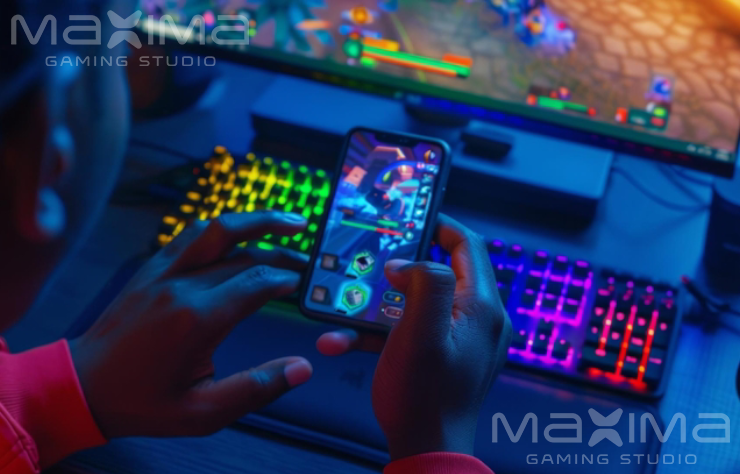 October 1, 2025
October 1, 2025
Cross-Platform Game Development: Challenges & Best Practices
In 2025, the global gaming industry is no longer bound to a single device. Players expect to seamlessly enjoy games on PCs, consoles, smartphones, tablets, and even smart TVs. This growing demand has made cross-platform game development a core strategy for studios.
However, developing a game that runs smoothly across multiple platforms is not easy. From performance optimization to UI adjustments, developers face a unique set of challenges. This article explores the major challenges in cross-platform game development and the best practices that help studios deliver consistent, high-quality experiences.
Why Cross-Platform Development Matters
- Wider Audience Reach: Launching on multiple platforms increases visibility and potential user base.
- Higher Revenue Potential: Monetization opportunities expand when you tap into different ecosystems.
- Player Freedom: Gamers today expect to switch between devices (e.g., play on console at home and continue on mobile while traveling).
- Future-Proofing: With cloud gaming and Web3 integrations rising, being cross-platform ensures long-term adaptability.
Challenges in Cross-Platform Game Development
1. Performance Optimization
- Different platforms have varied hardware capabilities.
- A high-end PC can run advanced shaders, but mobile devices may struggle with the same code.
- Balancing performance without losing visual quality is one of the biggest hurdles.
2. Device Fragmentation
- Android alone has thousands of device models with varying screen sizes, GPUs, and RAM.
- Ensuring consistency across devices requires extensive testing.
3. Control Schemes & User Experience
- A game built for a console controller might not feel intuitive on mobile touchscreens.
- Developers need adaptive UI/UX designs that fit the input method.
4. Middleware & SDK Conflicts
- Many platforms require different SDKs, APIs, or compliance checks.
- A feature that works on PC may break on console due to licensing or integration conflicts.
5. Certification & Store Compliance
- Each platform (Steam, PlayStation Store, App Store, Google Play, Xbox Marketplace) has unique certification requirements.
- Delays or rejections can slow down launch timelines.
6. Multiplayer & Cross-Play Issues
- Cross-play requires synchronized servers, fair matchmaking, and compliance with different network rules (Sony, Microsoft, Apple, Google).
- Ensuring balanced competition between PC and mobile players is challenging.
Best Practices for Cross-Platform Game Development
1. Choose the Right Game Engine
- Unity: Ideal for indie to mid-scale projects with mobile + console support.
- Unreal Engine: Great for AAA-quality graphics and large-scale projects.
- Godot / Custom Engines: Flexible but require more in-house development.
2. Modular & Scalable Codebase
- Keep the core game logic platform-independent.
- Write modular code where platform-specific adjustments (UI, performance tweaks) can be swapped in.
3. Use Adaptive Graphics & Dynamic Scaling
- Implement LOD (Level of Detail) systems.
- Allow dynamic resolution scaling for smoother performance on low-end devices.
4. Cloud Saves & Account Systems
- Let players sync progress across devices.
- Example: Fortnite allows seamless progression from PC → console → mobile.
5. Flexible UI/UX Design
- Design UI that auto-adjusts to screen size, resolution, and input method.
- Provide multiple control schemes (controller, keyboard/mouse, touchscreen).
6. Rigorous Testing & QA
- Test across multiple devices and platforms early in development.
- Use automated testing tools to catch performance drops, UI bugs, and input mismatches.
7. Optimize Multiplayer & Networking
- Use dedicated servers for fair cross-play.
- Implement cross-platform matchmaking filters (PC players vs console/mobile).
8. Compliance & Legal Readiness
- Stay updated with store guidelines, certifications, and regulations.
- Example: iOS app submissions often require specific privacy disclosures.
Case Studies
- Fortnite: A benchmark in cross-platform play, supporting PC, console, and mobile with shared progression.
- Minecraft: “Bedrock Edition” unified gameplay across platforms, boosting community growth.
- Genshin Impact: Successfully optimized high-quality visuals for both mobile and PC.
Future of Cross-Platform Gaming
- Cloud Gaming (Xbox Cloud, NVIDIA GeForce NOW, Jio Cloud Gaming) will reduce device dependency.
- WebAssembly & Progressive Web Apps may allow high-quality browser-based games.
- AI-driven optimization tools will automatically adjust graphics and performance per device.
Conclusion
Cross-platform game development is both a challenge and an opportunity. Developers must navigate device fragmentation, performance gaps, and compliance hurdles — but the reward is a massive, global player base. By choosing the right engine, optimizing performance, and focusing on flexible design, studios can build games that truly unite players across devices.


